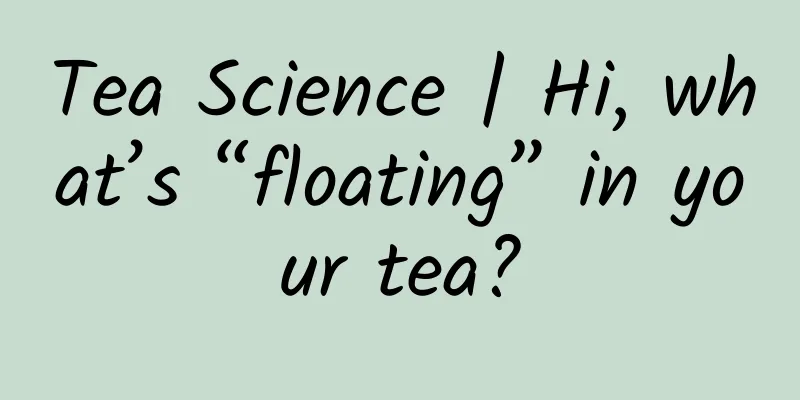Tea Science | Hi, what’s “floating” in your tea?

|
When you are making tea, if you find some tiny floating objects in the tea soup, don't be anxious, take a closer look, it is possible that they are not impurities, but the hairs of tea buds and leaves. What is bud fuzz? Trichomes, also known as white hair, tea hair, and hair, are single-cell coverings protruding from the epidermal cells on the back of young buds and leaves of tea plants. Its structure is simple, and it is a single-cell tissue protruding from the epidermal cells. It is slender, translucent, conical, and silky in shape, and its color is silvery white. Its length and density are related to the variety and distribution location. ▲ Scanning electron microscope image of bud and leaf hairs What are the ecological functions of bud and leaf hairs? Image source: References [3] 1. Waterproof protection: The bud and leaf hairs can effectively slow down water evaporation and help tea trees retain moisture under drought conditions. 2. Resist ultraviolet rays: The hairy surface of buds and leaves can reflect part of the sunlight, reducing the damage of ultraviolet rays to tea trees. 3. Insect-proof function: The tiny hairs on the buds and leaves can prevent the invasion of pests to a certain extent and play a protective role. Does the fuzz on buds and leaves have anything to do with the quality of tea? The bud and leaf hairs are not only a natural protection for the plant, but they may also affect the overall quality of the tea: 1. Appearance: It has a lot of hairs, which is usually regarded as one of the signs of tender buds and leaves and high-quality tea. 2. Different teas have different requirements: Some high-quality white teas, green teas and black teas generally tend to have obvious tea hairs. For example, Baihao Yinzhen usually requires full white hairs, Xinyang Maojian often requires obvious tea hairs to enhance the freshness of the tea soup, and Huangshan Jinhao generally requires obvious golden hairs to enhance its uniqueness. 3. Is the hair an absolute standard for judging the quality of tea? No! Because some tea varieties have no hair on their buds and leaves, and some famous teas are required to be smooth and hair-free. When you are drinking tea, If you find tiny floating objects in the tea soup, Look carefully, In addition to possible impurities, There may also be fine bud and leaf hairs. Buds and leaves are hairy, Not only is it part of the natural growth of tea trees, It is also a reflection of the quality of tea. Next time you make tea, Let's take a look. Let's use what we learned today to identify If it is bud leaf hair, Please enjoy the unique tea aroma and flavor! (Pictures from the Internet) References: [1] Guo Yuanchao, 1993. Morphological characteristics and evolutionary features of tea tree hairs[J]. Tea Science Bulletin (3): 1-4. [2] HU Mengqin. Molecular basis of tea hair development regulation[D]. Hunan Agricultural University, 2021. [3] LI P, XU Y, ZHANG Y, FU J, YU S, GUO H, CHEN Z, CHEN C, YANG X, WANG S, ZHAO J(2020). Metabolite Profiling and Transcriptome Analysis Revealed the Chemical Contributions of Tea Trichomes to Tea Flavors and Tea Plant Defenses. Journal of agricultural and food chemistry, 68(41). [4] LI P, ZHANG Y, YE Z, ZUO H, LI P, ZHAO X, CHEN Z, CHEN C, ZHAO J, LI P, ZHANG Y, YE Z, ZUO H, LI P, ZHAO 2(1): 1-13. [5] TOZIN LR dos S, SILVA SC de M, RODRIGUES TM, 2016. Non-glandular trichomes in Lamiaceae and Verbenaceae species: morphological and histochemical features indicate more than physical protection[J/OL]. New Zealand Journal of Botany, 54(4), 446–457. [6] YAMASAKI S, SHIMADA E, KUWANO T, KAWANO T, NOGUCHI N, 2010. Continuous UV-B Irradiation Induces Endoreduplication and Peroxidase Activity in Epidermal Cells Surrounding Trichomes on Cucumber Cotyledons[J/OL]. Journal of Radiation Research, 51(2): 187-196. Contributor: Fu Zhilu, Tea Research Institute, Chinese Academy of Agricultural Sciences Reviewer: Liu Xu, Associate Researcher, Tea Research Institute, Chinese Academy of Agricultural Sciences, Chen Liang, Researcher, Tea Research Institute, Chinese Academy of Agricultural Sciences |
Recommend
Do you have to charge your phone to 100%? This is a big misunderstanding
The reason why most people have to replace their ...
How much does it cost to join the rubber and plastic mini program in Nanjing?
How much does it cost to join a rubber and plasti...
What are the requirements for joining Baidu AiPurchasing? How much does Baidu Aicaigou promotion cost?
If we say that industrial manufacturing companies...
Fast charging vs flash charging! What is the difference between the two charging methods? Finally figured it out
As mobile phones become more and more powerful Ev...
Who is "obstructing" forest carbon storage? It's the microorganisms in the soil!
Popular Science Times (intern Wang Yuke) Forests ...
Fire protection maintenance technical service mini program function, how much does it cost to develop a WeChat fire protection mini program?
Fire safety is more important than anything else. ...
He gained 330,000 followers in one event, and used these 3 secrets to make his circle of friends explode!
As we all know, online activities, especially onl...
IDC: AI-driven smartphone spending will reach $32 billion in 2028
IDC's 2025 Asia Pacific (excluding Japan) cus...
Douyin traffic and fan increase methods and operation guide!
With the advent of the 5G era, short videos are s...
How to operate a WeChat official account for a tool-type product?
As we all know, various Internet products are now...
The essence of APP product operation, passionate speeches by operation masters such as Didi and Meitu
Didi Product Director Ye Keji: The core of produc...
XCode6.0 iOS certificate-free real machine testing method (valid for both MAC and Hackintosh)
[[121733]] Currently, iOS programs developed on X...
World Asthma Day丨How can we breathe more comfortably and freely?
Today (May 3) is World Asthma Day. In recent year...
iPhone 6 running score exposed again
iPhone 6 has just started pre-sale, so if you wan...
How much does it cost to customize the Yibin used car mini program? What is the price for customizing the Yibin used car mini program?
The main factors affecting the price of mini prog...









